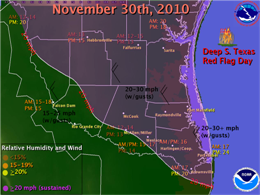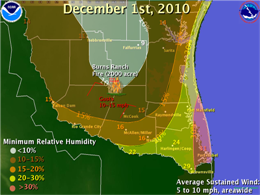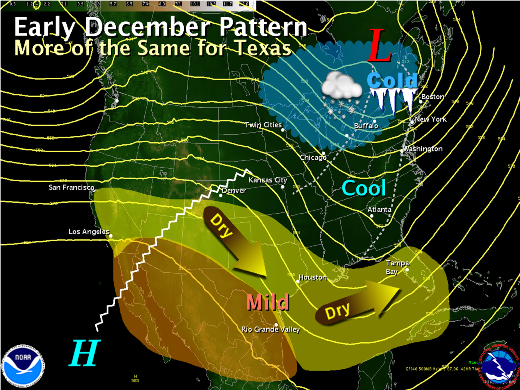|
Event
Very low relative humidity combined with puffs of afternoon wind up to 15 mph to help rapidly spread a brush fire across 2,000 acres of the Burns Ranch, which includes 38,000 acres of land including property in the four corners of Brooks, Starr, Jim Hogg, and Hidalgo Counties, starting at around 130 PM on the afternoon of December 1st and continuing until the predawn hours of December 2nd. In all, more than 50 trucks and hundreds of pieces of equipment were sent by 24 local fire departments, as well as the U.S. Fish and Wildlife Service and Texas Forest Service. The fire was extinguished on December 2nd, but smoldering muck remained until at least December 3rd. The ranch is known to have many oil tanks and oil and gas pipelines running through it. This is the same ranch which was scorched by a more than 25,000 acre wildfire in 2008. Interestingly, both this fire and another situation on November 5th near La Joya (two small fires burning 68 and 17 acres) occurred on afternoons with minimum relative humidity near or below 10 per cent with sustained winds 10 mph or less.
Outlook
Since the start of October, Deep South Texas has literally turned off the spigot which provided rainfall, in some areas too much rainfall, in September. The following shows the October/November Rainfall Percentile, and the October/November Standardized Precipitation Index for the United States. Note how the Rio Grande Valley is in the exceptionally dry category. Through at least mid December (below), more dry fronts are expected to reinforce the rapidly drying soils, with little or no rainfall expected. To track the evolution of the drought through the Standardized Precipitation Index, click here.
Preventive Measures
Burn bans will likely become a reality as the calendar moves deeper into winter, but the threat is already increasing with the rapid drying underway. The best way to stop a wildfire from spreading is to stop it before it starts! The following tips can help ensure residents, first responders, and trained fire fighters can stay safe.
The Texas Forest Service offers the following tips, known as the "Three E’s of Wildfire Prevention"
- Education. Wildfire prevention efforts target a wide variety of audiences using a broad mix of messages, publications, activities and programs. Smokey Bear, the national symbol for wildfire prevention, has reached millions of children, youth and adults with his wildfire safety message: “Only you can prevent wildfires.” The Smokey Bear wildfire prevention campaign remains one of the most successful public service programs ever undertaken by the National Advertising Council.
Using materials and presentations appropriate for different audiences, fire prevention educators take wildfire safety programs to schools and youth groups, civic clubs, landowner associations and other targeted groups. Fire safety professionals also enlist the help of the news media to educate the public about wildfire danger, fire prevention and home fire safety practices, and weather events likely to increase the risk of wildfires. Fire risk assessment personnel help keep governmental leaders informed on wildfire activity and current and predicted danger levels to enable these officials to make informed decisions about possible outdoor fire restrictions and fire use.
Even if burn bans are not in effect, open air debris or trash burning is not recommended this December.
-
-
- Engineering. Proper equipment maintenance can help prevent many wildfires, e.g. keeping mufflers and spark arresters on outdoor power equipment in proper working order. Modifications on equipment and/or the environment in which equipment is being used also can prevent wildfires. Examples include removing vegetation from the area in which welding operations will be conducted and physically shielding potential ignition sources from dry vegetation.
-
-
- Enforcement. The enforcement side of wildfire prevention involves activities that encourage compliance with restrictions on outdoor fire use, usually based on penalties for noncompliance with state or county regulations. In Texas, enforcement efforts most commonly involve citations for negligence with outdoor burning, violations of county burning bans and restrictions on the sale of certain aerial fireworks.
A burn ban doesn’t have to be in effect for outdoor burning to be illegal. Negligently allowing your fire to escape onto someone else’s property is also Class C misdemeanor offense (the same as violation of a burn ban) that is punishable by a fine up to $500. Deliberately setting fire to someone else’s property is arson, which is a felony offense punishable by a fine of up to $10,000 and a prison term of from 2 years to 99 years in prison.
|


